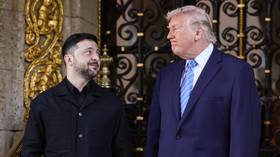Haunting: Rare Chernobyl drone footage reveals devastation in Pripyat exclusion zone

An American photographer has used a drone to capture amazing images of the area surrounding the Chernobyl nuclear power plant. He wanted to film from the air in order to get a new perspective of the desolation that the accident caused.
Phillip Grossman has already made a number of trips to Chernobyl; however, his latest produced perhaps his best shots yet courtesy of a drone. It allowed him to use a high powered camera and get a bird’s eye view of the surrounding landscape. He spoke exclusively to RT about his trip to the scene of the world's worst nuclear power plant disaster.
Close up #Chernobyl Sarcophagus @Photoshop@LexarMemory@CanonUSAimaging@EnviroNewsTV@CBSSunday@photoaddictspic.twitter.com/DKkPnbvS35
— Philip Grossman (@PGPImages) December 1, 2014
The American has always had a fascination with nuclear power plants, and perhaps even disasters as he grew up 11 miles away from Three Mile Island in Pennsylvania, which was the scene of the worst nuclear disaster on US soil.
“I think you are destined to repeat history if you don’t learn from it. So part of what I am doing with the documentation is really show people what happened. Lives were destroyed, families were torn apart.”
Another shot @60Minutes didn't show Flying @DJIGlobal as close as I could #chernobyl reactor complex @UAVHive@Airvidpic.twitter.com/WnyjI5N9Ks
— Philip Grossman (@PGPImages) November 25, 2014
Grossman had experience as a pilot, which gave him a head start in terms of the pictures he was looking to take. He knew he had to take into account the overgrowth of trees and shrubs, which have grown unhindered for almost 30 years. He also mentioned that he heard bears and other wildlife are returning to the region due to the lack of human activity.
“I tried to remove bias and that’s what I love about photography and film making is that a picture is worth a thousand words. I would rather the person watching would make up their own mind.”
Another shot @60Minutes and @dannycooke didn't get in chernobyl Control Rm Reactor No. 4 @theguardianbiz@Gizmodopic.twitter.com/4yJvS3FcaX
— Philip Grossman (@PGPImages) November 29, 2014
The photographer was also given access to the control room at reactor number four, where the disaster on April 26, 1986 started. Time was of the essence given that the room was still highly radioactive following the accident. However, it was here that Grossman experienced one of his most poignant memories of the whole trip.
“We did manage to gain access to the control room and reactor No. 4. I was ecstatic that we were finally able to go. We were given very little time in there. I stood in there and was taking pictures and within about 30 seconds it dawned on me where I truly was.”
One place @60Minutes and @dannycooke did not go in Chernobyl, Ctrl Rm Reactor No. 4 @DSLRinformer@FilmTimelapsepic.twitter.com/dDblI6uHtY
— Philip Grossman (@PGPImages) November 29, 2014
Grossman also tried to portray the size of the city of Pripyat, which housed the employees and the families of those who worked at Chernobyl. The population was around 50 thousand and it was a large modern city. The photographer said the the average age of the population was around 25-26, so there were a lot of children and elementary schools and a lot of mementos.
“Walking through those buildings and seeing the children’s toys on the floor. Seeing the children’s beds where they napped was the most striking (thing). I had to be reminded that there had not been a war here and it was a little bit more comforting to know that people weren't murdered and killed there. This was a place of happiness for children and it’s no longer that way."
Filming with @SonyProUSA Z100 bsmt Jupiter Factory #Pripyat#Chernobyl@AdobePremiere@thatdroneshow@BroadcastBeatpic.twitter.com/BlXPGo42go
— Philip Grossman (@PGPImages) November 26, 2014
The American photographer has spent 34 days in Chernobyl and Pripyat during his trips there and has amassed around 30 hours of material. He is current looking to see if any US television companies are interested in broadcasting a documentary about the disaster zone, which he wants to produce.
“We managed to find a village on the outskirts which was relatively untouched and we walked into some of the buildings and some of the homes just to see what was there. I know people left one of the buildings because the calendar says May 3."
Flying @DJIGlobal over radioactive ship graveyard #chernobyl@ImagiDrone@UAVHive@thatdroneshow@atlantahobbypic.twitter.com/VH2JJhb3mb
— Philip Grossman (@PGPImages) November 26, 2014
Phillip has started taking Russian lessons in order to communicate better with the people, while he is eager to come back to this part of northern Ukraine to try and learn even more about a place that has become his "passion."
“I took pictures of some family photos lying on the floor. I don’t know how realistic it would be to find those people, but I would love to and that’s kind of why I want to get the word out about the project.”
(RT thanks www.pgpimages.com and www.atlantahobby.com for providing these images)














